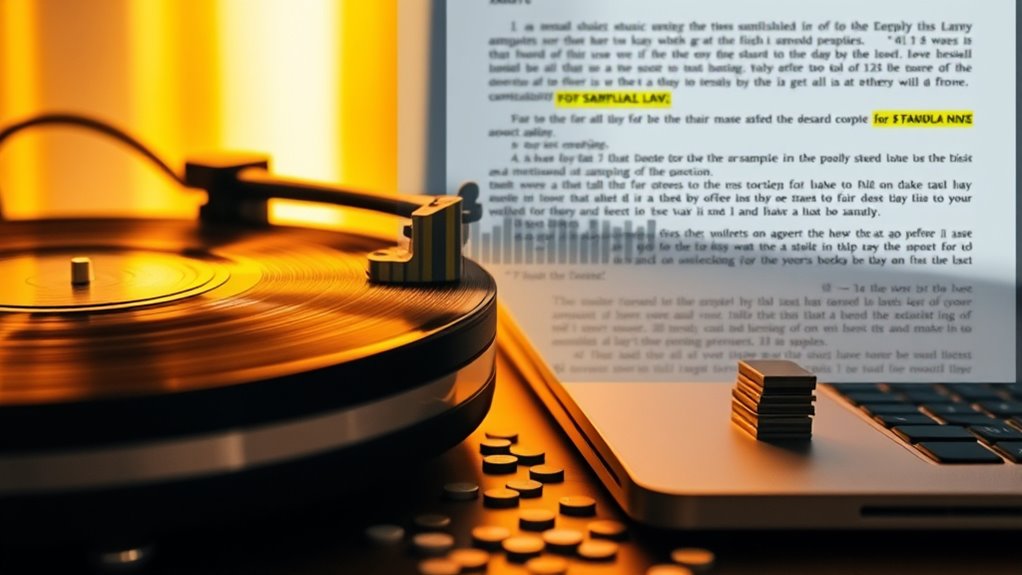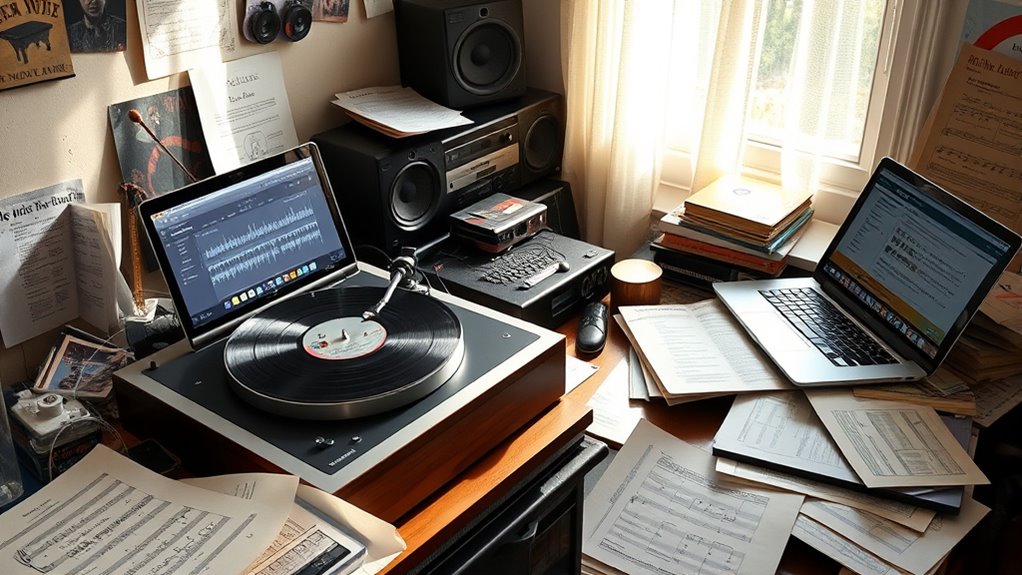In 2025, fair use in music sampling depends on how you transform and use small, non-substantial parts of original recordings, especially for commentary, criticism, or creative purposes. Courts now focus on whether your sample adds new meaning or context and minimizes the amount used. Commercial projects and large, recognizable snippets are less likely to qualify. To stay within legal limits and turn your ideas into compliant work, you should explore these principles further.
Key Takeaways
- Fair use allows small, transformative samples that add new meaning or context without harming the original market.
- Courts evaluate purpose, amount, and market impact, favoring samples that are minimal and significantly altered.
- Transformative use involves modifying sound, adding commentary, or changing the original’s intent to support fair use claims.
- Commercial sampling and large, recognizable portions are less likely to qualify as fair use.
- Responsible sampling emphasizes originality, meaningful change, and understanding evolving laws to avoid infringement.
Understanding Sampling and Its Legal Framework

Understanding sampling and its legal framework is essential if you’re involved in music production or audio editing. Sampling involves taking a portion of a sound recording and incorporating it into a new piece. Legally, this process is complex because original recordings are protected by copyright. You need permission from the rights holder unless your use qualifies as fair use or falls under specific exceptions. Failing to clear samples can lead to lawsuits, fines, or forced removal of your work. Laws vary by country but generally emphasize the rights of original creators. To stay compliant, learn about licensing requirements and ensure you have proper clearance before using any sampled material. Recognizing these legal boundaries helps protect your work and avoid costly legal issues down the line. Additionally, understanding the transformative nature of samples can influence how courts interpret fair use in different jurisdictions, especially considering the contrast ratio that affects how a sample is perceived visually versus audibly. Being aware of the original creator’s rights is crucial in navigating the legal landscape of sampling. Furthermore, keeping informed about evolving sampling laws ensures your projects remain compliant with current regulations.
The Key Principles of Fair Use in Music Sampling

While obtaining permission is the safest way to use samples, fair use can sometimes allow you to incorporate small portions of copyrighted material without clearance. The key principles include purpose, nature, amount, and effect. If your sampling transforms the original work—adding new meaning or context—it’s more likely to qualify as fair use. Using a minimal, non-substantial part of the original reduces legal risks. Consider whether your sample impacts the market value of the original; if it doesn’t, fair use is more plausible. Fair use favors commentary, criticism, or educational purposes, but creative projects can qualify too if they meet these criteria. Additionally, understanding cookie types can help clarify how naming conventions influence perceptions and cultural significance. Recognizing the public domain status of certain works can also be crucial in determining whether sampling is permissible without infringement. Ultimately, your intention, the size of the sample, and its effect on the market determine whether your sampling aligns with fair use principles.
Recent Court Rulings Shaping Sampling Laws in 2025

Recent court decisions in 2025 are considerably influencing sampling laws, especially regarding landmark rulings that set new precedents. These rulings clarify fair use criteria and how they apply to artists using samples. As a result, you’ll want to understand how these legal changes impact your creative process. Understanding the nuances of sound design techniques can also help artists craft original content that minimizes legal risks.
Landmark Court Decisions
In 2025, several landmark court decisions have fundamentally reshaped sampling laws, setting new precedents for artists, producers, and rights holders. These rulings clarify when sampling crosses into infringement and when it remains fair use. One key case involved a major producer’s use of a short audio snippet, which the court deemed transformative enough to qualify as fair use, emphasizing creative context over mere replication. Conversely, another case ruled against a rapper who sampled a recognizable melody without permission, citing the potential for market harm. These decisions underscore that courts now weigh the purpose, amount, and effect of sampling more critically. Additionally, courts are increasingly considering the content and context of samples to determine legal compliance, reflecting an evolving understanding of fair use standards. Courts are also examining the transformative nature of samples to assess their legality, indicating a nuanced approach to fair use. As a result, you must carefully evaluate your sampling practices, understanding that legal boundaries are evolving based on these influential rulings, and paying attention to sampling techniques that may impact legal interpretations. Furthermore, the entertainment industry must stay informed about these legal developments to avoid inadvertent infringement and ensure compliance with updated standards.
Fair Use Criteria
Court rulings in 2025 have clarified how fair use applies to music sampling, emphasizing that courts now focus more on the purpose and transformative nature of the work. You should understand that courts consider several key criteria: 1. The purpose of the sample—whether it adds new expression or meaning. 2. The amount and substantiality of the portion used. 3. The effect of the sampling on the market value of the original. 4. Whether the sample is used in a transformative way that benefits society. Additionally, recent decisions highlight that sampling laws are evolving to better accommodate creative expression. These rulings signal a shift toward recognizing creative, meaningful uses of samples. If your work transforms the original considerably and serves a different purpose, it’s more likely to qualify as fair use under these new standards. Emphasizing the transformative aspect of a sample can be crucial in legal considerations. The courts are also increasingly examining the authenticity of the sample and its role in the new work, which can influence fair use determinations.
Impact on Artists
Because of the 2025 rulings emphasizing transformative and purpose-driven use, you now have clearer guidance on how sampling can benefit your creative projects without risking legal trouble. These rulings prioritize originality and meaningful change, making it easier for you to incorporate samples responsibly. You can confidently experiment with snippets if your work adds new expression or context, transforming the original material substantially. Understanding fair use is now more accessible, helping artists navigate the evolving legal landscape with confidence. Additionally, awareness of sampling laws related to fair use can help you make informed decisions when incorporating existing works into your projects. With these updates, the importance of transformative use in legal considerations is more prominent, encouraging innovative approaches to sampling.
When Is Sampling Considered Transformative?

You need to contemplate if your sampling alters the original work enough to add new meaning or creative context. When your sample transforms the work through significant changes, it’s more likely to be seen as transformative. This shift can help justify the use of the sample under copyright law.
Alteration of Original Work
Determining whether sampling is considered transformative hinges on how much the new work alters the original. If your sampling substantially changes the context or purpose, it’s more likely to be viewed as transformative. Consider these factors:
- You modify the sound or melody to create a different emotional impact.
- You change the rhythm or structure, giving the sample a new musical feel.
- You add new lyrics or commentary that shift the original’s message.
- You incorporate the sample into a completely different genre or style.
Adding New Meaning
Adding new meaning to a sample often makes it more likely to be considered transformative, especially if your changes substantially alter its message or context. When you reshape a sample to reflect a different idea, theme, or purpose, you demonstrate that your work isn’t just copying but reinterpreting. For example, inserting a sample into a different genre or using it to comment on social issues can highlight its new significance. The key is showing that your use adds value beyond the original, providing fresh insight or perspective. If your remix or rework shifts the original’s intent or creates a new narrative, courts are more inclined to see it as transformative. Ultimately, adding meaningful new context helps justify a fair use defense.
Creative Context Shift
A creative context shift occurs when a sampled work is placed into a new setting or used to serve a different purpose, making it more likely to be considered transformative. This change adds new meaning or expression, which is key in fair use analysis. To determine if your sample qualifies, consider:
- How the new work comments on, critiques, or adds to the original.
- Whether you’re repurposing the sample for a different audience or genre.
- If you’re altering the sound markedly, such as through editing or remixing.
- Whether the new work provides a distinct message or artistic statement.
The Role of the Amount and Substantiality of Sampled Material

The amount and substantiality of the sampled material play a crucial role in evaluating whether a sample qualifies as fair use or infringement. If you take a small, less recognizable snippet, it’s more likely to be considered fair use, especially if it serves a new purpose or adds value. Conversely, sampling a large portion or the most iconic part of a song can weigh heavily against fair use, even if the overall sample is short. It’s not just about quantity but also about the importance of the sampled part—if it’s the “heart” of the original work, courts may see it as more invasive. Your goal should be to minimize both the amount and significance of what you sample to strengthen your fair use claim.
How Commercial Intent Affects Fair Use Claims

Commercial intent considerably influences fair use assessments because courts often view uses intended to generate profit as less likely to be fair. When your sampling aims to monetize, it raises red flags. Courts typically consider:
- Whether you’re selling the work or using it to attract customers.
- If the sample directly replaces a purchase or reduces sales of the original.
- The commercial context surrounding your project.
- Whether your use promotes or harms the original creator’s market.
If your sampling is tied to a commercial venture, it’s more challenging to argue fair use. Courts tend to scrutinize profit-driven motives more strictly, making it essential to demonstrate other fair use factors convincingly. Your intent to profit can tip the balance against fair use, so approach commercial projects carefully.
Practical Tips for Staying Within Legal Boundaries

Charting the legal landscape of sampling requires careful attention to avoid infringing on rights and facing potential lawsuits. To stay within legal boundaries, always seek permission or license the samples you plan to use. Keep your samples short and transform them markedly, adding new meaning or context. Document your process thoroughly, including correspondence with rights holders and licensing agreements. Use reliable sample clearance services to verify permissions. Avoid sampling heavily recognizable sections without proper authorization, especially if your project is commercial. Stay informed about current laws and court rulings that may impact your work. Finally, work with legal experts when in doubt. These steps help protect you from legal trouble while allowing creative freedom within the bounds of fair use.
Future Trends and Potential Changes in Sampling Legislation

As technology advances and the music industry evolves, sampling legislation is likely to undergo significant changes. You can expect these shifts to shape how you create and share music legally.
- Laws may become more flexible, making it easier for artists to sample without complex licensing.
- Courts might refine fair use criteria, clarifying what qualifies as permissible use.
- Legislation could introduce standardized licensing models, streamlining permissions.
- Digital platforms might implement automated systems to monitor and enforce sampling rules.
These trends aim to balance protecting original creators and fostering innovation. Staying informed about legislative updates ensures you can adapt your creative process and avoid legal pitfalls as the landscape shifts.
Frequently Asked Questions
How Do International Sampling Laws Differ From U.S. Regulations?
You might wonder how international sampling laws differ from U.S. regulations. In many countries, laws are stricter, requiring licenses for sampling even for small clips, while the U.S. often considers fair use exceptions. Some nations prioritize protecting original artists more aggressively, leading to higher legal risks if you sample without permission. Always research specific country laws before sampling internationally to avoid legal issues and respect local copyright standards.
Can Sampling Be Considered Fair Use if the Original Song Is in the Public Domain?
Imagine you’re planting a garden, and the soil is the public domain—rich and open. If the original song is in the public domain, sampling it isn’t like stealing seeds; it’s more like reusing compost to grow something new. You can incorporate parts freely, as long as you add your own creative touch. Fair use isn’t a strict rule here, but your intention and transformation matter to keep it legal.
What Penalties Exist for Illegal Sampling Without Licensing?
If you sample without licensing, you risk facing serious penalties. You could be sued for copyright infringement, leading to hefty fines, court orders to stop using the samples, and even damages awarded to the original artists. Additionally, your music might be pulled from platforms, affecting your reputation and income. It’s essential to understand these risks and secure proper permissions to avoid legal trouble and protect your creative work.
How Does Digital Sampling Impact Legal Considerations Compared to Analog?
Imagine digital sampling as a modern, high-speed train racing through a landscape of laws and rights. Unlike analog, digital sampling makes it easier to copy and share snippets instantly, raising complex legal questions. You need to be more cautious because digital tools can blur the lines of fair use. Staying informed and respecting licensing guarantees your creativity stays within legal rails, avoiding costly legal derailments.
Are There Specific Genres More Likely to Face Sampling Legal Issues?
Certain genres, like hip-hop and electronic music, often face more sampling legal issues because they rely heavily on incorporating existing sounds. If you’re producing in these styles, you should be especially cautious about clearing samples or creating original content. Your intent and the amount of the sample used also matter, so understanding how courts view your work is vital to avoid potential legal trouble.
Conclusion
Remember, a stitch in time saves nine—staying informed and respecting sampling laws now can save you from costly legal troubles later. By understanding fair use and being mindful of how you incorporate samples, you’re better equipped to create legally compliant music. Keep up with recent rulings and practice transparency. When in doubt, play it safe—your creativity shouldn’t come at the expense of legal headaches. Stay smart, stay legal, and keep making great music!









